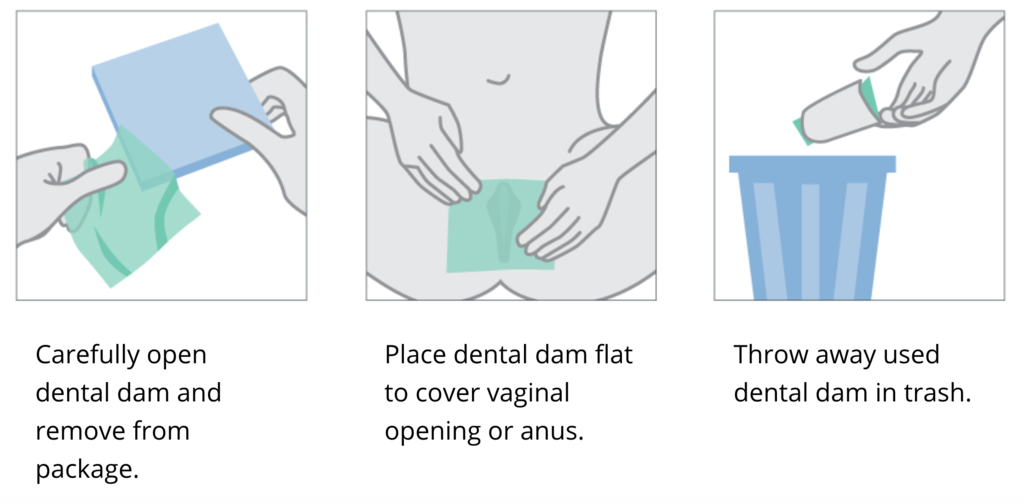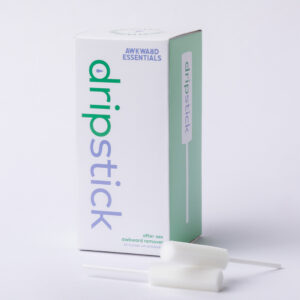Dental Dams for Oral Sex: The Short History
SexForEveryBody.com is supported by our readers. We may earn a commission if you buy through links on our site. Learn more.

A Millenial who grew up in Canada, I never learned about dental dams in sex education in high school. I did learn about condoms, both the more popular condom that covers the penis and the “female condom” that goes inside the vagina.
It wasn’t until university when I was writing a Women’s Studies paper on lesbians and the HIV/AIDS epidiemic that I discovered dental dams and I was stunned. How could I have never heard about them before? Why did it have to take my relatively obscure research to find out?
Using dental dams for oral sex didn’t seem particularly appealing, but still it made me wonder who else was missing this information. Hopefully I’m more of an outlier. Though as I suspect I am not, I’ve shared more information on using dental dams for oral sex below.
What are dental dams?
Dental dams are thin, rectangular pieces of latex or polyurethane that are used as a barrier during oral sex to reduce the risk of sexually transmitted infections (STIs), including HIV. Scientific research has shown that when placed over the genital area, anus, or rectum during oral sex, they create a physical barrier that can help prevent the exchange of bodily fluids.
Originally, dental dams were developed for use in dentistry to isolate the teeth and gums during certain procedures. The first recorded use of a dental dam was in 1864, by an American dentist named Sanford Christie Barnum.
In the 1980s and 1990s, during the HIV/AIDS pandemic, dental dams gained popularity as a way to reduce the risk of HIV transmission during oral sex.
Today, dental dams are specifically designed for use during oral sex to help reduce the risk of sexually transmitted infections (STIs). Dental dams for oral sex, inlcuding wearable dental dam panties, are regulated and classified as medical devices by the US Food and Drug Administration (FDA).
Dental dams are not as widely used or available to buy as condoms. In fact, there is limited research on the popularity and use of dental dams in particular.
In general, the use of barrier methods such as condoms and dental dams is relatively low compared to other methods of STI prevention such as hormonal contraceptives or PrEP (pre-exposure prophylaxis). This may be due to a variety of factors, including lack of awareness or availability of these products, cultural or personal attitudes towards their use, and discomfort or inconvenience associated with using them.
Dental dams are most commonly used during oral-vaginal sex or oral-anal sex. They can be used by people of any gender or sexual orientation. Some people use dental dams to help reduce the risk of STIs when engaging in oral sex, while others may use them as an additional layer of protection in addition to other methods of STI prevention such as condoms or PrEP (pre-exposure prophylaxis).
It is important to use dental dams consistently and correctly to help reduce the risk of STIs.
How to use dental dams for oral sex

Dental dams can be effective at reducing the risk of sexually transmitted infections (STIs) when used consistently and correctly during oral sex.
Here are some dos and don’ts for using dental dams as a barrier for STI transmission during oral sex:
Dos:
- Use a new, lubricated dental dam each time you have oral sex.
- Check that the dental dam is not past its expiration date.
- Make sure the dental dam covers the entire genital or anal area.
- Hold the dental dam in place while you perform oral sex.
Don’ts:
- Don’t stretch or cut the dental dam, as this can weaken it and make it less effective.
- Don’t reuse a dental dam.
- Don’t use a dental dam that is torn, punctured, or otherwise damaged.
- Don’t use a dental dam as a substitute for a condom during vaginal or anal sex.Don’t use the same dental dam for both oral and genital or anal contact.
It’s also important to note that dental dams are not a substitute for other forms of protection, such as condoms or pre-exposure prophylaxis (PrEP). To reduce the risk of STIs, it is recommended to use multiple forms of protection, such as condoms and dental dams, and to get tested regularly. It’s also important to communicate with your sexual partner(s) about their STI status and to practice safe sex.
How effective are dental dams?
The efficiency of dental dams for preventing STI transmission has been the subject of debate among health organizations and experts. Some studies have shown that properly used dental dams can effectively reduce the risk of STI transmission during oral sex, while others have found that they may not be as effective as other barrier methods, such as condoms.
One potential limitation of dental dams is that they must be used correctly in order to be effective. This may require additional education and training for individuals who wish to use them, which can be a barrier to their widespread adoption. In addition, some people may find dental dams to be uncomfortable or unpleasant to use, which can reduce their effectiveness.
Despite these challenges, dental dams remain a valuable option for preventing STI transmission during oral sex. The Centers for Disease Control and Prevention (CDC) recommends dental dams, along with other safe sex practices, such as condom use and regular STI testing, to reduce the risk of STI transmission.
Dental dams have a relatively short history as a barrier method for preventing STI transmission during oral sex. Their efficiency for this purpose has been the subject of debate, but they remain a valuable option when used correctly and in combination with other safe sex practices.
Where to buy dental dams for oral sex?
To be legally sold in the United States, dental dams must be registered with the FDA and meet certain safety and effectiveness standards. There are many brands of dental dams available, and they can be found at most stores that sell sexual health products or online.
A quick Google search will likely bring up some online options or show you some stores in your area selling dental dams. That being said, dental dams are not anywhere as popular as condoms and you can’t count on your local drug store, pharmacy or CVS to carry them.
You may want to try online retailer Condomania, which sells the most popular types of dental dams for oral sex. Their selection includes flavoured dental dams, as well as latex and non-latex dental dams.
Non-latex dental dams for oral sex

Latex is the most commonly used material to make dental dams, but some individuals may be allergic or experience adverse reactions. To meet to needs of people with latex allergies or sensitivities, non-latex dental dam options have been developed.
One popular dental dam for oral sex is the Harmony Polyisoprene, which comes in a six-pack. As then name impiies, Harmony creates its non-latex dental dams out of Polyisoprene. Polyisoprene is a synthetic polymer, sometimes likened to a synthetic rubber material.
Each dental damn sheet is 6 inches by 10 inches. The brand says they’re “super thin so that your partner can feel all the sensations your tongue has to offer.”
What are dental dam panties?

There are some products on the market that are designed to function as dental dams and be worn as underwear. These products typically consist of a pair of panties made of a stretchy, latex-free material that can be placed over the vulva during oral sex to help reduce the risk of sexually transmitted infections (STIs).
Lorals is a popular brand of dental dam underwear created by Melanie Cristol. She developed the product after being unable to find a dental dam while on her honeymoon. Lorals are cleared by the FDA to protect against STIs.
To use dental dam panties, you would put them on like any other pair of underwear and adjust them so that they cover the vulva. The dam material should be smooth and taut, without any wrinkles or folds. During oral sex, the person performing oral sex would simply place their mouth over the dam material and perform oral sex as they would normally.
It’s important to note that dental dam panties are not a substitute for other forms of protection, such as condoms or pre-exposure prophylaxis (PrEP). To reduce the risk of STIs, it is recommended to use multiple forms of protection, such as condoms and dental dams, and to get tested regularly. It’s also important to communicate with your sexual partner(s) about their STI status and to practice safe sex.
Sex For Every Body® is an online publication that celebrates sexual and body diversity.
Our goal is to make sex education resources easier to access and more inclusive, particularly to people living with disabilities and those healing from sexual trauma.
In addition to sharing adult sex-ed resources and guides, we also offer updates and analyses on issues related to sexual health, sexual education, and sexual expression. Learn more about Sex For Every Body®.












